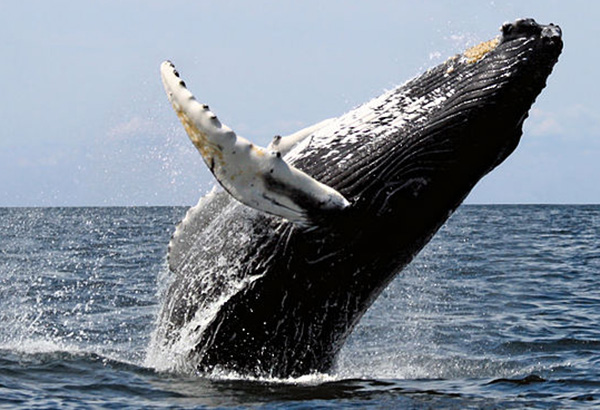Whale Aerodynamics
Today whale aerodynamics. The University of Houston's College of Engineering presents this series about the machines that make our civilization run and about the people whose ingenuity created them.
We've all seen movies of humpback whales playing in the sea. The most obvious feature is a nice symmetrical tail slapping the water as it dives. But we also see an awkward-looking flipper emerging as it breaches the water. That flipper fin has white lumps along its edge - lumps called tubercles.

A Humpback Whale breaching and displaying the tubercles on the leading edge of its left fin. (Image courtesy of Wikipedia Commons)

You might even have noticed a Pacific Life Insurance ad that ends as a humpback whale leaps out of the water, and that lumpy fin freezes into its logo. That flipper fin seems so crudely made. But it's not what it seems. It's actually a highly mobile wing that gives the whale fine control of its movement in water.
So think how wings work: Most of us have, sometime, reached our hand out of a moving car's window, palm slanted toward the wind, and felt it lift like an airfoil. At a zero angle of attack (or zero tilt) our hand knifes through the air, feeling no lift and little drag. Increase the angle and lift pulls our hand up while drag pushes it back. Those forces increase with the angle. But let the angle of attack be great enough and our hand suddenly jerks back - no more lift and a huge increase in drag. We call that the stall angle. That's because air moving over the top suddenly detaches, leaving a large vacuum.
 |
| An airfoil whose angle of attack causes it to stall. (Image Courtesy of Wikimedia Commons) |
When an airplane reaches that point, the wing stops lifting it. Instead, it drags the airplane to a halt. It stalls, then falls. Airplane designers have tried many ways to slow the onset of stall - to make it more progressive, less sudden. We've looked out airplane windows and noticed all kinds of gadgets on their wings - rows of little vertical plates, for example.
Now we find that the humpback whale might have the best gadget of them all. You see, the flow of air is similar to the flow of water. A whale moves in water much as an airplane moves much faster in air. Evenly spaced tubercles channel water (or air) back across the flipper (or wing) in vortices. And either water or air clings longer to the fin (or to the wing) as the angle of attack increases. That action is complex. But as engineers write the equations and do computer simulations, they also make new products - wind turbine blades with bumpy leading edges, bumpy fins reaching down from below fancy surfboards.

A tubercle-enhanced wind turbine blade built and photographed by Joe Subirona, by permission of WhalePower Corporation. Note that the tubercles have been greatly enhanced in this design.
At this writing, I've yet to see them on a jet wing. But, if you hear this episode in a rerun, you might have. And I think of how early airplane makers looked at birds and saw all the wrong things. They saw flapping wings, but missed the fine control of feathers. Our theoretical knowledge of nature was still too rudimentary. Our photography couldn't yet capture the right details. Only now are our labs and our math catching up with the stunning sophistication of creatures around us. We've learned to look to the sea to understand the air. And, we finally see what a thing of beauty that lumpy humpback whale flipper really is.
I'm John Lienhard at the University of Houston, where we're interested in the way inventive minds work.
F. E. Fish, P. W. Weber, M. M. Murray, and L. E. Howle, The Tubercles on Humpback Whales' Flippers: Application of Bio-Inspired Technology. Integrative and Comparative Biology, vol. 51, No. 1, pp. 203-213.
My thanks to Stephen Dewar of WhalePower Corp. for his counsel. Dewar made a point that I have not emphasized in this episode: It is how radically tubercle-enhanced flow over a blade differs from conventional flow over an airfoil. The vortices emanating from the tubercles are completely unlike the straight flow of air over conventional wings.
This episode was first aired on March 18, 2014